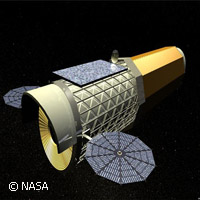'Hidden' surfaces to shed light on black holes
At its recently extended X-ray Pencil Beam Facility (XPBF), Germany's national metrology institute is analysing the quality of key features of the mirror design for the planned International X-Ray Observatory (IXO), which is expected to set out on a detailed investigation of supermassive black holes in 2021. IXO, which is to become the largest X-ray telescope ever built, is a joint endeavour of ESA (European Space Agency), NASA (National Aeronautics and Space Administration) and JAXA (Japanese Aerospace Exploration Agency). The planned IXO mission focuses on the investigation of supermassive black holes - a type of black hole thought to have developed at the beginning of the universe, possibly even before the first stars were formed. New information about these phenomena should therefore provide astronomers with valuable insights into our planetary past. IXO will also take a closer look at neutron stars and stellar black holes, which are formed by supernova explosions of particularly massive stars. The cartography of the black holes to be studied will be provided by the eROSITA ('Extended Roentgen survey with an imaging telescope array') experiment, a German-Russian cooperation headed up by the Max Planck Institute for Extraterrestrial Physics. Due to be launched within the next three years, eROSITA will scour the skies with the help of a bundle of seven X-ray telescopes. As part of a wider remit, it is expected to find approximately 3 million black holes. IXO will build on this crucial input to conduct a systematic investigation by capturing the X-radiation of very distant black holes. To do so, it will require a gigantic mirror. In view of the specific nature of X-radiation, this mirror will be composed of individual components arranged to reflect the rays sideways, at an extremely shallow angle, rather than face-on. The Physikalisch-Technische Bundesanstalt (PTB), Germany's national metrology institute providing scientific and technical services, is testing key features of these components. Announcing its intervention on 27 September 2010, the PTB outlined the specifics of the mirror design: 'IXO will have one single mirror with a collection surface of approximately 3m2 (square metres), a focal length of 20 metres (m) and an angular resolution of less than 5 arc seconds. Due to the required grazing radiation incidence, the whole surface of the mirror must be approximately 1,300m2.' This mirror will be constructed using commercially available, highly polished silicon wafers designed with ribs enabling them to be stacked in rigid blocks. 'Through this,' noted the PTB, 'pores with a cross-section of approximately 1mm2 are formed in which the radiation is reflected at the surface of the respective lower wafer.' The institute, which is analysing the reflecting surface of individual pores, adds that 'with regard to tangent errors and roughness, the quality of these "hidden" surfaces cannot be investigated as usual from above, but must be determined in the intended application geometry with X-ray reflection at grazing incident angles of approximately 1°.' A monochromatic pencil beam with a diameter of 50 micrometres and a divergency of less than 1 arc second will be used. The necessary infrastructure is now available at the newly extended X-ray Pencil Beam Facility (XPBF) of the institute's synchrotron radiation laboratory at BESSY II in Berlin-Adlersdorf, Germany. 'It will characterise the X-ray lens systems for IXO at three different photon energies, i.e. at 1keV [kiloelectron volt], 2.8keV and 7.6keV ' the PTB announced. 'The lens systems can be adjusted or turned with a hexapod in vacuum with reproducibilities of 2 micrometres or below 1', respectively. The direct beam and the reflected beam are registered with a spatial resolving detector based on CCD (charge-coupled device) at a distance of 5m or 20m from the lens system. For the last-mentioned distance, which corresponds to the intended focal length of IXO, a vertical movement of the CCD detector by more than 2m has been implemented.' An initial round of tests was performed in May 2010, and further tests are scheduled from November 2010.
Countries
Germany, Japan, Russia, United States



